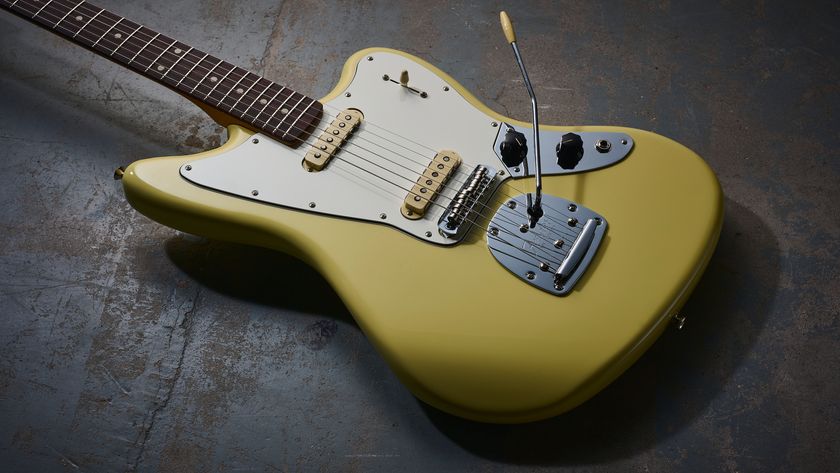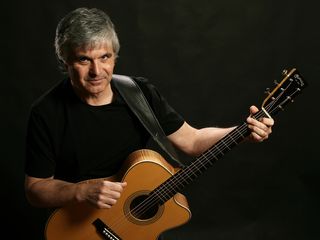
Laurence Juber talks Paul McCartney and new photo book Guitar With Wings
In 1978, Paul McCartney was looking for a new Wings axeman to fill the spot vacated by Jimmy McCulloch, who had left the group to join a revamped lineup of the Small Faces. "Do you know any good guitar players?" McCartney asked his longtime bandmate Denny Laine, who answered, "It just so happens that I do."
Laine's recommendation was British session guitarist Laurence Juber, whose versatile, elegant playing rounded out the Wings sound from '78 until the group's end in 1981. Juber, who has called Los Angeles his home for the past three decades, embarked on a successful second career as a studio musician and has released almost two dozen solo releases. But in the recently released book, Guitar With Wings: A Photographic Memoir, he looks back on his days working with an ex-Beatles in one of the '70s biggest bands.
The 250-page book (co-authored by Marshall Terrill and featuring a foreword by Denny Laine) contains over 200 previously unpublished photos, and for Juber, the year-long process of assembling the material was often filled with surprises. "I didn’t even know I had all of these photos," he says. "Some of them were on film rolls – they weren’t even on contact sheets. So it was nice to uncover it all and look at them and go, ‘Ah! I remember that…’”
Guitar With Wings: A Photographic Memoir can be purchased at Dalton Watson Fine Books and Guitar With Wings. In the following interview, Juber talks about his time with Paul McCartney and Wings, and on the pages that follows, he discusses a selection of the photos from the book.
Was Wings a happy group? Did it function well?
“It did function well, really, because it was like a family. Well, it was a family – you had a very happily married couple, Paul and Linda. There were some issues… Denny was an integral member and was in Wings throughout. A certain amount of tension developed because Denny’s wife, Jo Jo, and the McCartneys didn’t get along that well. But the band itself didn’t have issues. It was a really productive experience.”
Did Paul ever talk about some of the things that went wrong with The Beatles – stuff he wanted to avoid with Wings?
“He didn’t typically talk about The Beatles that much. Once in a while, he’d say something like, ‘In my old band…’ He’d make passing comments. He’d mention The Beatles if something was going on, if Yoko had said something in the press or there was a point of business – then he’d have a reaction. The Beatles weren’t really front and center, by any means.”
The Beatles had a bit of one-upmanship in the studio – sometimes Paul even played guitar parts that some people initially attributed to George. Was there ever any of that in Wings? Any battles over who would play which parts?
“Once in a while. With the song Getting Closer, Paul really wanted to play a rhythm guitar part on that, so he did. But there were plenty of times when it was wide open for me to make the contribution I wanted to make. Sometimes when we were jamming, Paul would play something and I would emulate it or add to it – we’d get in a bit of a cutting contest, as it were. But it was a very reasonable and productive creative relationship.”
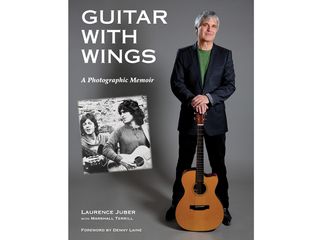
Laurence Juber talks Paul McCartney and new photo book Guitar With Wings
What are some moments that stand out to you as real highlights from your time in the band?
“My favorite moment of the lot is when we were doing the Kampuchea concerts. To precede that, it was when we were in Abbey Road doing the Rockestra session, which was Paul’s idea of a rock orchestra. It was Wings, members of Led Zeppelin, The Who, Pink Floyd – many amazing musicians. We recorded two songs, the Rockestra Theme, which subsequently won a Grammy for rock instrumental, and a song called So Glad To See You Here. It was a remarkable experience.
“Paul wanted to re-create that when we did the Kampuchea concerts, and on the last night we did the set of three songs with Rockestra; we did Lucille, Let It Be and the Rockestra Theme. We didn’t do many Beatles songs; we opened with Got To Get You Into My Life, and then we had Fool On The Hill, Let It Be and Yesterday.
“On Let It Be, there was a spotlight on me to take a solo. Paul wasn’t big on extended guitar solos, so I had to pick my moments – Let It Be was one of those moments. When it came to time for the solo, there were about a dozen guitar players on stage, but I realized that nobody was going to step forward to play the lead. It was my role to do so, and that’s what I did.
“Halfway through, that’s when I thought, ‘Wow, I’m on stage playing Let It Be with Paul McCartney. John Bonham’s on drums… ‘ In my mind, I ran through everybody I was on stage with. Just then, a hint of brandy fumes went up my nose, and I realized that Pete Townshend was leering over my shoulder as I was playing. I had this epiphany on stage, a transcendent moment that was tempered by a slightly brandy-soaked Pete Townshend watching me. I thought to myself, ‘How cool is this?’” [Laughs]
It’s no secret that Linda was mercilessly derided by the critics during the Wing years. Did she have a pretty thick skin, or did the criticism sting, do you think?
“Yeah, it stung, but she was a practical woman – she wasn’t going to get completely depressed by it. She developed a fairly thick skin, as you say.”
Were you surprised when the group ended? Did you see it coming at all?
“I saw it coming. Clearly, Wings was in what I call its ‘Indian summer’ when I joined; it was in its last incarnation. Wings existed because Paul wanted to work with Linda, and Denny was a very useful foil and was somebody of a similar background, although he did have his own credentials. Linda was really integral to it all, but when James was born – now we’re getting to 1977 – it was getting hard for her. They had the kids in school, and they didn’t want to disrupt their lives for a year to do a big ol’ year-long world tour.
“It was clear that there wasn’t a lengthy future for the band, but for me the whole thing was a gift. It was a great honor to work with Paul McCartney – and Denny Laine, for that matter. And Linda had this great rock ‘n’ roll sensibility that really tied it all together. Paul’s Japanese bust put an end to touring, which was a shame – we would have done those dates and then continued to Europe and America. That was the summer of 1980, so we would have been touring with a number record and could have ended the band with a bang. But the band did continue on till the spring of 1981. I had already moved to New York in January of ’81 because I knew things were winding down, which they did.”
How's your relationship with Paul been over the years?
“It’s always been very friendly. I see him on occasion – when he’s playing in LA, I go and say hello. I’m of a different era from Paul – I’m 10 years younger – so it’s not like we’re going to go out and have tea. But we’ve stayed in touch.”
Photos reprinted from the book GUITAR WITH WINGS by Laurence Juber with Marshall Terrill. Copyright © 2014 by Dalton Watson Fine Books. Published by Dalton Watson Fine Books, Deerfield IL 60015 USA
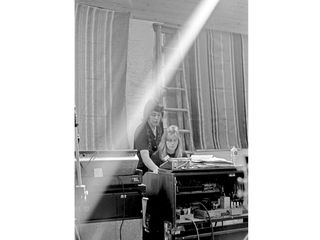
Paul and Linda
“Paul was showing Linda some kind of chord shape on the Hammond B3. I think we were playing the song Again And Again And Again – she played organ on that one. I love the fact that there’s a spray can of contact cleaner on the top. Those old analogue devices needed a fair amount of maintenance.
“This was in Scotland, in the barn. There’s a beam of sunlight shining through the skylight and into the studio. That corner of the room had the Fender Rhodes and the Minimoog and the ARP synthesizer as well.”
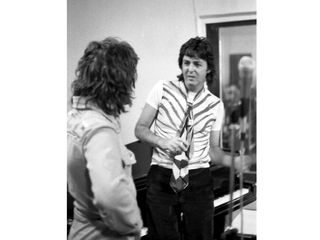
Denny Laine and Paul
“That’s an interesting combination on Paul, this striped T-shirt and a weird-looking tie. He and Denny are discussing a song arrangement. You can see that Paul is making a sort of air-guitar gesture.”
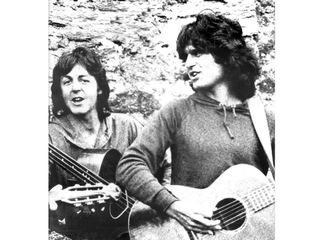
Paul and Laurence
“Paul is playing a Zemaitis acoustic bass. I’m playing a little Gibson acoustic – I think it belonged to Denny, actually.
“That was done during a very quick photo session we did on the farm. The engineer, Phil McDonald, took the picture and gave it to me. It was used about a year later for the cover of an English guitar magazine.”
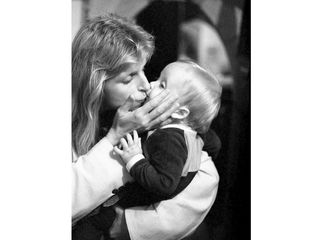
Linda and James McCartney
“Linda and James. I love that picture – mother and child. James was not even a year old at that point. He was around a great deal.
“Linda was pretty busy. She was doing double-duty, playing keyboards and being a full-time mom, too. She had a little bit of help, but not a lot.”
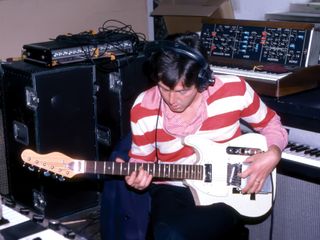
Paul playing Gizmotron-equipped Tele
“It might not look like it, but it’s actually a knock-off Telecaster that Paul turned upside-down. At some point he must’ve hacked off part of the guitar to give himself a cutaway, most likely because he’s left-handed, so that was the only way to get to those upper frets.
“The guitar has on it a prototype of a device called a Gizmotron, which was invented by Lol Creme and Kevin Godley from 10cc. You pressed the device and it bowed the string, so you got this very different sound, not of a plucked string but one that was bowed.
“We used that to create a fake orchestra. There are some background sections on Back To The Egg that aren’t real orchestra at all; it’s me doing guitar synth stuff and Paul using the Gizmotron – and various other devices like Mellotrons.”
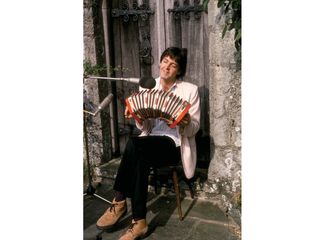
Paul playing a Concertina
“Paul’s playing a squeezebox called a Concertina – a very basic instrument. We were doing a song called How Many Million Miles from Back To The Egg.
“That’s a shot of an actual take. Paul is actually sitting outside on a balcony that overlooks the English Channel, recording his vocal and playing the squeezebox live.”
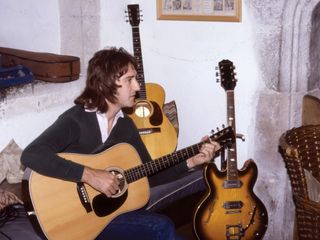
Denny on acoustic guitar
“Denny is playing my Martin D-28 there. I think he was just fooling around with it. Denny with an acoustic guitar is always the image I have of him, the folk-minstral kind of thing.
“Next to him is Paul’s Epiphone Casino that goes back to The Beatles. He used that guitar on many Beatles tracks as well as songs on McCartney and Band On The Run – it was his go-to guitar. I think that Paul got the Casino in ’64, and then John and George got theirs a little later. You see pictures of them on the ’66 tour and they’re playing the Epiphones.
“In the back is a Japanese knock-off of a Martin, and over Denny’s shoulder is a violin case. We were in the castle – there were all kinds of instruments around.”
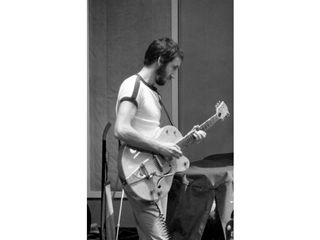
Pete Townshend
“Pete Townshend playing a Gretsch. This was when we were recording the Rockestra stuff – the theme and So Glad To See You Here.
“What’s really funny is the vacuum cleaner behind him. I mean, here we are doing this huge session in Abbey Road; they’ve got a film crew and the whole bit, and there's this studio vacuum cleaner still standing in the corner. It almost looks as if Pete is plugged into it – that’s how he gets his tone.”
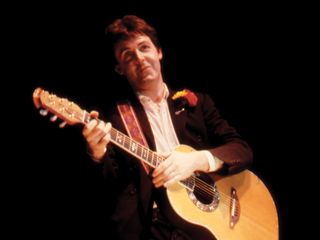
Paul on stage
“That’s one of my brother’s pictures. Paul is playing his Ovation. He used it on Yesterday, I think. He had it tuned down a whole step because he would play with these G shapes, although he sung it in F.
“For songs in standard tuning, like Mull Of Kintyre, he would play his Martin D-28, which goes back to the White Album days.”
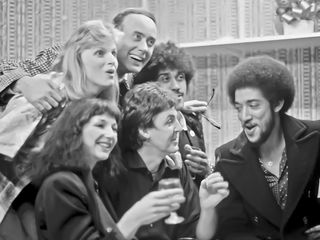
Backstage
“That’s the great Victor Spinetti, who people remember from A Hard Day’s Night, in the back. And then we’ve got Kate Bush on the lower left. To the left of Paul is Phil Lynott from Thin Lizzy, and the man on the right is Leon Nocentelli, the wonderful funk guitar player from The Meters.
“The shot was taken backstage at Wembley. On the same page of the book is a picture of my mom meeting Paul for the first time. Omar Shariff was in the room too, and my mom couldn’t keep her eyes off of him. She’s busy shaking hands with Paul while gazing at Omar. It was rather funny.”

Joe is a freelance journalist who has, over the past few decades, interviewed hundreds of guitarists for Guitar World, Guitar Player, MusicRadar and Classic Rock. He is also a former editor of Guitar World, contributing writer for Guitar Aficionado and VP of A&R for Island Records. He’s an enthusiastic guitarist, but he’s nowhere near the likes of the people he interviews. Surprisingly, his skills are more suited to the drums. If you need a drummer for your Beatles tribute band, look him up.
![Nuno Bettencourt [left] of Extreme wears a star-patterned vest and plays his Washburn N4 electric guitar onstage; Teen prodigy Taj Farrant plays his Kiesel singlecut during an afternoon slot at Lollapalooza 2024.](https://cdn.mos.cms.futurecdn.net/arRqcm7XEDN9EmEpn2JTsJ-840-80.jpg)
“We may be witnessing a true future guitar hero in our midst”: Aussie teenager Taj Farrant officially blows Nuno Bettencourt’s mind as Extreme guitarist describes the blues-rock phenom as SRV meets EVH
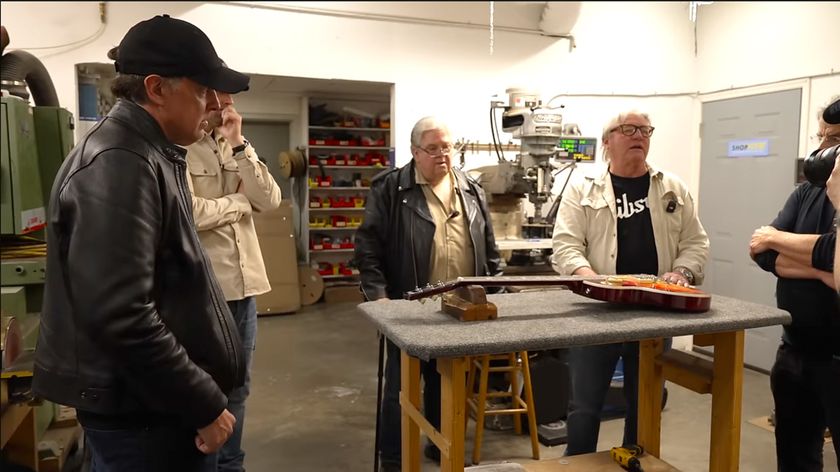
“It’s just heartbreaking to see someone spend so much money on something that is fake”: YouTuber assembles team of guitar experts including Joe Bonamassa and Gibson's Tom Murphy to show you how to spot a fake Les Paul
![Nuno Bettencourt [left] of Extreme wears a star-patterned vest and plays his Washburn N4 electric guitar onstage; Teen prodigy Taj Farrant plays his Kiesel singlecut during an afternoon slot at Lollapalooza 2024.](https://cdn.mos.cms.futurecdn.net/arRqcm7XEDN9EmEpn2JTsJ-840-80.jpg)
“We may be witnessing a true future guitar hero in our midst”: Aussie teenager Taj Farrant officially blows Nuno Bettencourt’s mind as Extreme guitarist describes the blues-rock phenom as SRV meets EVH

“It’s just heartbreaking to see someone spend so much money on something that is fake”: YouTuber assembles team of guitar experts including Joe Bonamassa and Gibson's Tom Murphy to show you how to spot a fake Les Paul
Most Popular








